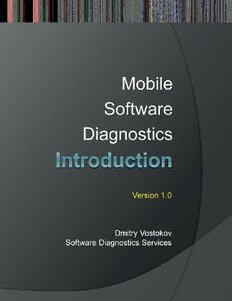
Mobile Software Diagnostics: An Introduction PDF
Preview Mobile Software Diagnostics: An Introduction
Published by OpenTask, Republic of Ireland Copyright © 2013 by OpenTask Copyright © 2013 by Software Diagnostics Services Copyright © 2013 by Dmitry Vostokov All rights reserved. No part of this book may be reproduced, stored in a retrieval system, or transmitted, in any form or by any means, without the prior written permission of the publisher. You must not circulate this book in any other binding or cover, and you must impose the same condition on any acquirer. Product and company names mentioned in this book may be trademarks of their owners. OpenTask books and magazines are available through booksellers and distributors worldwide. For further information or comments send requests to [email protected]. A CIP catalogue record for this book is available from the British Library. ISBN-l3: 978-1-908043-65-8 (Paperback) First printing, 2013 Revision 2.0 (July 2015) 2 Hello Everyone, my name is Dmitry Vostokov, and I introduce pattern-oriented mobile software diagnostics today. I decided to keep this presentation short and as simple as possible. If anything needs to be added or modified in the future, I create another version of it. Facebook: http://www.facebook.com/SoftwareDiagnosticsServices Linkedin: http://www.linkedin.com/company/software-diagnostics-services Twitter: http://twitter.com/DumpAnalysis 3 These prerequisites are very simple, and I suppose you all like me enjoy diagnosing software problems, troubleshooting and debugging. 4 This introductory presentation is either for desktop and server development and support engineers who are moving to mobile development and support and would like to reuse pattern-oriented software diagnostics there, but it is also for mobile development and support who want to learn about recent advances in pattern-oriented software diagnostics methodology originally coming from complex server environments. 5 The current state of mobile software diagnostics on some platforms (for example, memory dump analysis) is like desktop diagnostics decades ago. 6 However, all this is rapidly changing, and mobile devices now acquire hardware power that was unthinkable some time ago. Such devices might completely displace desktops even for traditional applications because it would be possible to connect mobile devices to large visualization devices to perform traditional desktop work such as editing and designing. 7 As hardware power increases the traditional desktop and server diagnostics ability also come in. For example, memory analysis role would increase and trace analysis would become more sophisticated on some mobile platforms. For example, the old methods of displaying message boxes for tracking variable values is dying as there is console log and tracing API for JavaScript. 8 So our vision is reuse of traditional desktop/server diagnostics methods and tools and with this come adoption of pattern orientation and unification of pattern catalogues and languages. Now I show you some slides from a few previous presentations mainly for those who are unfamiliar with pattern- oriented software diagnostics. 9 First, I would like to remind you a definition of pattern-oriented software diagnostics as pattern- driven and pattern-based. Pattern-driven: http://www.patterndiagnostics.com/Introduction-Software-Diagnostics-materials Pattern-based: http://www.patterndiagnostics.com/pattern-based-diagnostics-materials 10
